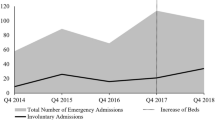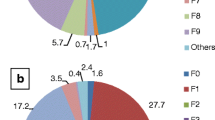Abstract
Involuntary psychiatric admission is a central issue in mental health care, especially in the treatment of children and adolescents. Its legal regulations do not only differ between European countries, but also on a federal level. Only few studies so far dealt with rates of involuntary admission (RIA), mainly focusing on adults, rather than children and adolescents. None of the studies analyzed this topic in a large cohort. The aim of this regional cross-sectional study was to compare voluntary and involuntary admissions in child and adolescent psychiatry (CAP) regarding personal and admission characteristics. Furthermore, risk factors and predictors of involuntary admission should be identified. A retrospective analysis of hospital admission registers from three major German CAP hospitals over a period of 6 years (2004–2009) was conducted (N = 10,547 inpatients). Group comparisons between involuntarily and voluntarily treated minors and a logistic regression to determine predictors of legal status were performed. Information on harm to self or others prior to the admission, medication and clinical outcome was not available due to data structure. 70.8 % of patients were voluntarily and 29.2 % involuntarily admitted. Both subsamples comprised more males. The RIA decreased consistently over the years, ranging from 25.7 to 32.4 %. The strongest predictor of being admitted involuntarily was suffering from mental retardation (OR = 15.74). Adolescence, substance abuse, psychotic disorders and admission on duty time were also strongly associated (OR > 3). In this first large cohort study on involuntary treatment of children and adolescents in Germany, about every fourth patient was treated involuntarily. Certain personal and disease-related factors increased the risk. Commitment laws and other legal instruments for regulating involuntary placements are inconsistent and a standardized description or systematic analysis is needed. The influence of demographic, institutional variables and care and health services aspects should also be investigated.
Similar content being viewed by others
References
Salize HJ, Dressing H (2004) Epidemiology of involuntary placement of mentally ill people across the European Union. Br J Psychiatry 184:163–168
Zinkler M, Priebe S (2002) Detention of the mentally ill in Europe—a review. Acta Psychiatr Scand 106:3–8
Lay B, Nordt C, Rössler W (2011) Variation in use of coercive measures in psychiatric hospitals. Eur Psychiatry 26:244–251
Steinert T, Martin V, Baur M, Bohnet U, Goebel R, Hermelink G, Kronstorfer R, Kuster W, Martinez-Funk B, Roser M, Schwink A, Voigtländer W (2007) Diagnosis-related frequency of compulsory measures in 10 German psychiatric hospitals and correlates with hospital characteristics. Soc Psychiatry Psychiatr Epidemiol 42:140–145
Valdes-Stauber J, Deinert H, Kilian R (2012) Deutsche unterbringungsrechtliche Praxis auf Bundes- und Länderebene nach Einführung des Betreuungsgesetzes (1992–2009). Fortschr Neurol Psychiatr 80:267–275
Ellila HT, Sourander A, Välimäki M, Warne T, Kaivosoja M (2008) The involuntary treatment of adolescent psychiatric inpatients—a nation-wide survey from Finland. J Adolesc 31:407–419
Kaltiala-Heino R (2004) Increase in involuntary psychiatric admissions of minors. Soc Psychiatry Psychiatr Epidemiol 39:53–59
Sourander A, Korkeila JA, Turunen MM (1998) Involuntary psychiatric hospital treatment among 2- to 17 years old in Finland: a national wide Register Study. Nord J Psychiatry 52:367–371
Worrall A, O’Herlihy A, Banerjee S, Jaffa T, Lelliott P, Hill P, Scott A, Brook H (2004) Inappropriate admission of young people with mental disorder to adult psychiatric wards and paediatric wards: cross sectional study of six months’ activity. BMJ 328:867
DGKJP. Deutsche Gesellschaft für Kinder- und Jugendpsychiatrie. Retrieved from: http://www.dgkjp.de/dgkjp/ueber-uns/short-informations. Accessed 5 May 2013
UN’s Convention of the Rights of the Child (1989) Retrieved from: http://www2.ohchr.org/english/law/crc.htm. Accessed 1 Nov 2012
Casmir KC, Billing SB (1994) Competency in adolescent inpatients. Bull Am Acad Psychiatry Law 22:19–29
Kaivosoja M (1999) Coercive help of children and adolescents in Finland. Psychiatria Fennica 30:214–224
Kunze-Turmann M, Wille J (1999) Freiheitsentziehung bei Kindern und Jugendlichen aus jugendpsychiatrischer und juristischer Sicht. Gesundheitswesen 61:548–552
Hoffmann B (2009) Freiheitsentziehende Unterbringung von Kindern und Jugendlichen—Rechtslage nach Neufassung des § 1631 b BGB und Inkrafttreten des FamFG. Recht Psychiatrie 27:121–129
Palant O (2010) BGB: Bürgerliches Gesetzbuch. Beck, München
Dodegge G, Zimmermann W (2003) PsychKG NRW. Gesetz über Hilfen und Schutzmaßnahmen bei psychischen Krankheiten. Praxiskommentar. Boorberg, Stuttgart
Müller P (2004) Zwangseinweisungen nehmen zu. Deutsches Ärzteblatt 101:A2794–A2798
Wierdsma A, Mulder C (2009) Does mental health service integration affect compulsory admissions? Int J Integr Care. Retrieved from: http://www.ijic.org/index.php/ijic/article/view/324/646. Accessed 1 Nov 2012
Siponen U, Välimäki M, Kaivosoja M, Marttunen M, Kaltiala-Heino R (2007) Increase in involuntary psychiatric treatment and child welfare placements in Finland 1996–2003: a nationwide retrospective study. Soc Psychiatry Psychiatr Epidemiol 42:146–152
Turunen S, Välimäki M, Kaltiala-Heino R (2010) Psychiatrists’ view of compulsory psychiatric care of minors. Int J Law Psychiatry 33:35–42
Bruxner G, Burvill P, Fazio S, Febbo S (1997) Aspects of psychiatric admission of migrants to hospitals in Perth, Western Australia. Aust NZ J Psychiatry 31:532–542
Opjordsmoen S, Friis S, Melle I, Haahr U, Johannessen JO, Larsen TK, R¢ssberg JI, Rund BR, Simonsen E, Vaglum P, McGlashan TH (2010) A 2-year follow-up of involuntary admission`s influence upon adherence and outcome in first-episode psychosis. Acta Psychiatr Scand 121:371–376
Opsal A, Clausen T, Kristensen Ø, Elvik I, Joa I, Larsen TK (2011) Involuntary hospitalization of first-episode psychosis with sustance abuse during a 2-year follow-up. Acta Psychiatr Scand 124:198–204
Khenissi C, Erkolahti R, Ilonen T, Saarijärvi S (2004) Adolescents` involuntary psychiatric treatment. Psychiatria Fennica 35:131–141
Mears A, White R, O′Herlihy A, Worral A, Banerjee S, Jaffa T, Hill P, Lelliott P (2003) Characteristics of the detained and informal child and adolescent psychiatric inpatient populations. Child Adolesc Mental Health 8:131–134
Watson TL, Bowers WA, Andersen AE (2002) Involuntary treatment of eating disorders. Am J Psychiatry 157:1806–1810
Delaney KR, Fogg L (2005) Patients characteristics and setting variables related to use of restraint on four inpatient psychiatric units for youths. Psychiatr Serv 56:186–192
Felkins B, Guthrie M, Walch J (1991) Voluntary or involuntary status of 50 adolescent inpatients. Hosp Community Psychiatry 42:1062–1063
Ulla S, Maritta V, Riittakerttu KH (2012) The use of coercive measures in adolescent psychiatric inpatient treatment: a nation-wide register study. Soc Psychiatry Psychiatr Epidemiol 47:1401–1408
IT.NRW, Landesbetrieb Information und Technik Nordrhein-Westfalen, Düsseldorf. Retrieved from: https://www.landesdatenbank.nrw.de. Accessed 1 Nov 2012
Rosca P, Bauer A, Grinshpoon A, Khawaled R, Mester R, Ponizovsky AM (2006) Rehospitalizations among psychiatric patients whose first admission was involuntary: a 10-year follow-up. Israel J Psychiatry Relat Sci 43(1):57–64
Wheeler A, Robinson E, Robinson G (2005) Admissions to acute psychiatric inpatient services in Auckland, New Zealand: a demographic and diagnostic review. N Z Med J 118(1226):U1752
Ellila HT, Välimäki M, Warne T, Sourander A (2007) Ideology of nursing care in child psychiatric inpatient treatment. Nurs Ethics 14:583–596
Hustoft K, Larsen TK, Auestad B, Joa I, Johannessen JO, Ruud T (2013) Predictors of involuntary hospitalizations to acute psychiatry. Int J Law Psychiatry 36(2):136–143
Iversen KI, Høyer G, Sexton H, Grønli OK (2002) Perceived coercion among patients admitted to acute wards in Norway. Nord J Psychiatry 56:433–439
Roberts RE, Atkinson CC, Rosenblatt A (1998) Prevalence of psychopathology among children and adolescents. Am J Psychiatry 155:715–725
Darsow-Schütte K, Müller P (2001) Zahl der Einweisungen nach PsychKG in 10 Jahren verdoppelt. Psychiatr Prax 28:226–229
Holtmann M, Duketis E, Poustka L, Zepf FD, Poustka F, Bölte S (2010) Bipolar Disorder in Children and Adolescents in Germany: National Trends in the Rates of Inpatients, 2000–2007. Bipolar Disord 12:155–163
Case BG, Olfson M, Marcus SC, Siegel C (2007) Trends in the inpatient mental health treatment of children and adolescents in US community hospitals between 1990 and 2000. Arch Gen Psychiatry 64:89–96
Figueroa R, Harman J, Engberg J (2004) Use of claims data to examine the impact of length of inpatient psychiatric stay on readmission rate. Psychiatr Serv 55:560–565
Rothärmel S (2006) Patientenaufklärung, Informationsbedürfnis und Informationspraxis in der Kinder- und Jugendpsychiatrie und Psychotherapie. Vandenhoeck & Ruprecht, Göttingen
Schmied K, Ernst K (1983) Isolierung und Zwangsinjektion im Urteil der betroffenen Patienten und des Pflegepersonals. Arch Psychiatr Nervenkr 233:211–222
Goren S, Curtis WJ (1996) Staff members’ beliefs about seclusion and restraint in child psychiatric hospitals. J Child Adolesc Psychiatr Nurs 9:7–14
Branik E (2004) Auswirkungen von Zwangsbehandlungen und -massnahmen auf die klinische und Beziehungsarbeit in der stationären Kinder- und Jugendpsychiatrie. Schweiz Arch Neurol Psychiatr 155:118–124
Armgart C, Schaub M, Hoffmann K, Illes F, Emons B, Jendreyschak J, Schramm A, Richter S, Leßmann JJ, Juckel G, Haußleiter IS (2013) [Negative Emotions and Understanding—Patients’ Perspective on Coercion]. Psychiatr Prax. Apr 30 (Epub ahead of print)
Haglund K, von Knorring L, von Essen L (2003) Forced medication in psychiatric care: patient experiences and nurse perceptions. J Psychiatr Ment Health Nurs 10:65–72
Gardner W, Lidz CW, Hoge SK, Monahan J, Eisenberg MM, Bennett NS, Mulvey EP, Roth LH (1999) Patients’ revision of their beliefs about the need for hospitalisation. Am J Psychiatry 156:1385–1391
Swartz MS, Swanson JW, Hannon MJ (2003) Does fear of coercion keep people away from mental health treatment? Behav Sci Law 21:459–472
Katsakou C, Bowers L, Amos T, Morriss R, Rose D, Wykes T, Priebe S (2010) Coercion and treatment satisfaction among involuntary patients. Psychiatr Serv 61:286–292
Georgieva I, Vesselinov R, Mulder CL (2012) Early detection of risk factors for seclusion and restraint: a prospective study. Early Interv Psychiatry. doi:10.1111/j.1751-7893.2011.00330.x
Acknowledgments
The authors gratefully acknowledge the collaborative partners in the LWL-PsychiatryNetwork, especially our colleagues in the child and adolescent psychiatry institutions.
Conflict of interest
The authors declare that they have no conflict of interest.
Author information
Authors and Affiliations
Corresponding author
Rights and permissions
About this article
Cite this article
Jendreyschak, J., Illes, F., Hoffmann, K. et al. Voluntary versus involuntary hospital admission in child and adolescent psychiatry: a German sample. Eur Child Adolesc Psychiatry 23, 151–161 (2014). https://doi.org/10.1007/s00787-013-0440-8
Received:
Accepted:
Published:
Issue Date:
DOI: https://doi.org/10.1007/s00787-013-0440-8




